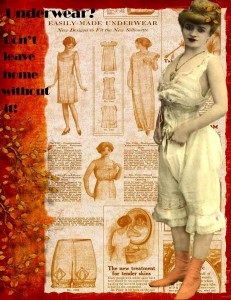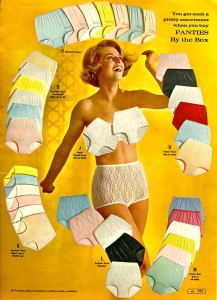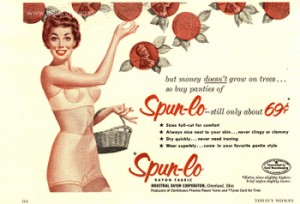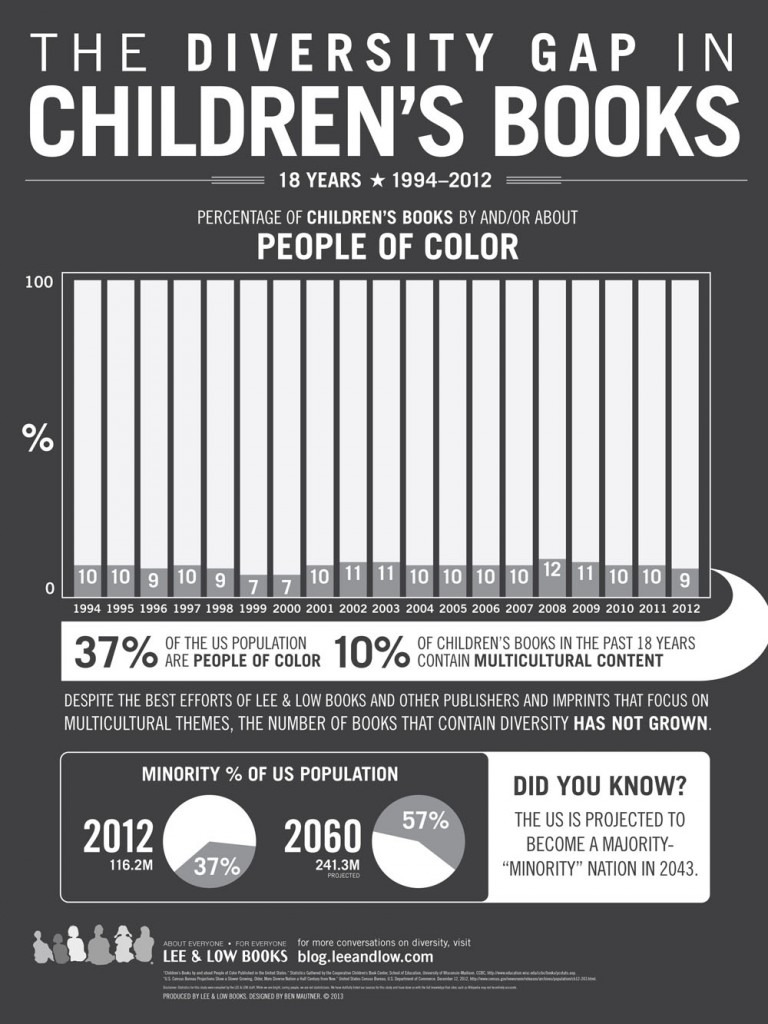It’s the best kind of summer morning – where the green smell that follows a good, soaking rain hasn’t yet dissipated, where there are all manner of things peeping, and chittering and tweeting in the yard. The sun is shining, although the keyboard is oddly sticky under my fingers; a remnant of a strange humidity which has wrapped our town in strangely balmy climes. It’s a morning to sit out on the back stairs, indolently reading the paper, with only a short terry bathrobe thrown over my granny panties and camisole, just warm enough, and just dressed enough.
Thrifty and practical, my grandmother provided matching camisoles and panties to me, from the time I was big enough to see over the edge of the table. Every birthday and Christmas, with unfailing regularity, a plain, brown-wrapped package would come in the post, containing the sprigged camisoles with the teeeeensy satin ribbon where my someday cleavage would live, with plain pastel cotton briefs. The Sears catalog provided these serviceable small-clothes, and, later, Walmart, when the sprawling megamart came to the tiny town of Patterson. I imagine her in her hard pink rollers, snapped into a sleeveless seersucker housedress, hunched over a cup of black coffee with the thick Sears catalogue before her, tracing with an arthritis-bent finger the tiny order numbers, and reading them carefully into the phone.
These were the clothes I lived in. Each night after my bath, I would choose a fresh set of underpants and pair it with a stretchy, cotton camisole, some scattered with tiny pink roses, others with blue, and be as dressed as I needed to be to run around the house and play. I remember my siblings in matching camis and briefs so clearly – they were the clothes I wore while drawing boobs on my Raggedy Ann, or watching my sister feed her Baby Alive while I tried to comb the hair on my Baby Fred (Yes. Fred. Poor Fred was a girl, but plastic hair does not take well to the pilot light on gas heaters, and my sisters renamed her Hard Head Fred, since her hair was a solid mass of burnt plastic. It’s a wonder I didn’t kill myself with the fumes. Do we sense a Doll Destruction theme? Another blog post, that). As I grew older, the granny gifts stayed the same – only their size increased. Surely I was the only fifth grader not wearing days-of-the-week underpants, or lace-trimmed, Strawberry Shortcake hip-huggers. Nope. I was still in my granny panties, hardly seeing anyone’s underwear other than mine and not knowing there was much else out there.
Up until junior high, anyway. By then, I had outpaced my grandmother’s ability to buy me camisoles, as she could no longer, at a glance, judge my size, and I had outpaced my desire to wear prim pastels which covered me from belly button to thigh. And yet, she still sent them. And, slips. Half slips, actually. The sort with scratchy lace on the bottom, which could be cut away, for the perfect length. I left them uncut, and mostly, unworn. I wanted underpants with stripes and contrasting piping. I wanted screen prints and ironic Wonder Woman symbols. Later, I wanted satin and silk and bikini cuts and bows and stars and stripes, bells, and whistles, and words on my unmentionables. And still, my grandmother kept sending those plain Jane, unexciting, unimaginative, flat cotton granny panties.
Even my mother had a collection, but her plain-wear expanded to include slips and nightgowns. Undyed, serviceable things which arrived each time she’d been sick, or feeling a little blue after a hospital visit. My grandmother wrapped her daughter’s frailties in strong cotton, enlivened with scraps of satin – a testament of a life filled with needful things, with little room for extras – simplicity with *ouches of beauty all the same.
Well past the time I should have lost my faint disdain for her gifts, my grandmother lost the ability to send them. She had never been wealthy, and after my bon-papa died, and her health declined, everything went toward keeping her tiny boat afloat. By then, her sharp memory for the birthdates of all twenty-seven plus grandchildren, not to mention greats, had faded a bit. My every birthday was no longer heralded by her scratchy, nearly monotone singing voice wishing me a happy birthday, and “May the Good Lawd Bless you,” her own invention for the second verse. By then, my life was full of other things, and other people, and the loss of those little brown-paper packages didn’t register as much. Until the first time I had to buy my own underwear. My own camisoles. My own nightgowns and bathrobes. And then, I realized there was one less person in the world who cared if I was properly covered, and who, if, God forbid, I was in an accident, would share a concern that I had underwear with tight elastic, no holes, and perfect seams.
I miss that.
So, in memory of my grandmother, I let Victoria keep her secrets, and buy my granny panties. Plain white cotton, some boy-legged, and much bigger than the current fashion. They’re no longer plain white – I tie dye them, I have to admit. From time to time, I even live a little, and buy black ones. I still don’t wear a slip – ever – and rarely a camisole, but I now have in my possession a tank with a scrap of lace at the neckline and the hem, and I feel just a little girlier to wear it. For me, that’s as good as it gets. I will never be the type of woman my grandmother was – fully starched, impeccably dressed, with her underpinnings all …pinned down – but at least I can embrace her simplicity, her lack of artifice, her straightforward, hard-knuckled, basic common sense, which, it turns out, is not all that common. Following her example, I can be myself from the skin out, and comfortable in the bargain. And really, that’s all that anyone can ask.






